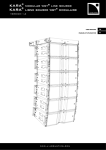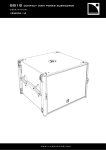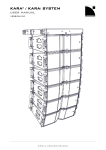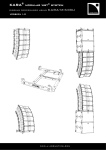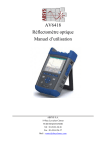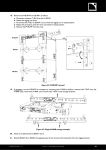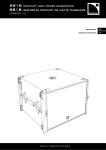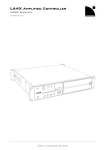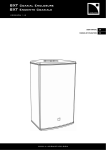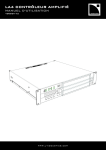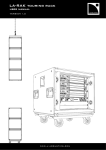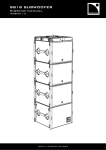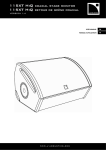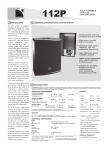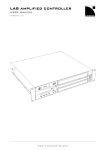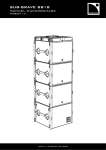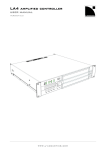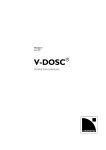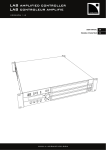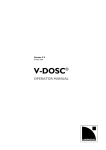Download KARA® - Audiobizz
Transcript
KARA® modular wst® line source USER MANUAL VERSION 1.1 1.1 www. l- aco usti cs. co m www.l-aco u sti cs.co m 1 SAFETY WARNINGS All information hereafter detailed applies for the L-ACOUSTICS® KARA® Modular WST® Line Source, designated in this section as ‘‘the product’’. 1.1 Symbol description EN Throughout this manual the potential risks are indicated by the following symbols: The WARNING symbol indicates a potential risk of physical harm to the user or people within close proximity to the product. In addition, the product may also be damaged. WARNING The CAUTION symbol notifies the user about information to prevent possible product damage. CAUTION The IMPORTANT symbol is a notification of an important recommendation of use. IMPORTANT 1.2 Important safety instructions 1. Read this manual 2. Heed all safety warnings 3. Follow all instructions 4. The user should never incorporate equipment or accessories not approved by L-ACOUSTICS® WARNING 5. Sound Levels Sound systems are capable of producing high Sound Pressure Levels which can be dangerous and potentially cause hearing damage especially when exposed to them over a long period of time. Do not stay within close proximity of the loudspeakers when operating. 6. Heat Do not operate the product near any heat source, such as radiators or other devices. CAUTION CAUTION WARNING 7. Water and moisture Even if the product is weather-resistant, it can not be exposed to moisture (rain, sea spray, shower, steam) for a long period of time, nor put in direct contact or partially immersed in water. This would cause irreversible damage to exposed components. 8. System parts and rigging inspection All system components must be inspected before use, in order to detect any possible defects. Please refer to the Care and Maintenance section of this manual as well as any other manuals pertaining to the system for a detailed description of the inspection procedure. Any part showing any sign of defect must immediately be put aside and withdrawn from use to be inspected by qualified service personnel. KARA_UM_ML_1-1 www.l-aco u sti cs.co m 1 en KARA® MODULAR WST® LINE SOURCE user manual VERSION 1.1 WARNING 9. Mounting instructions Do not place the product on an unstable cart, stand, tripod, bracket, or table. The product may fall and be seriously damaged, and may cause serious human injury. Any mounting of the product should follow the manufacturer’s instructions given in this manual, and should use a mounting accessory recommended by the manufacturer. 10. Conditions which require immediate service Servicing is required when the product has been damaged in any way such as: • The product has been exposed to rain or moisture. • The product was dropped or the enclosure is damaged. CAUTION • The product does not operate normally. IMPORTANT 1.3 11. Manual Keep this manual in a safe place during the product lifetime. This manual forms an integral part of the product. Reselling of the product is only possible if the user manual is available. Any changes made to the product have to be documented in writing and passed on to the buyer in the event of resale. EC declaration of conformity L-ACOUSTICS® 13 rue Levacher Cintrat Parc de la Fontaine de Jouvence 91462 Marcoussis Cedex France States that the following product: Loudspeaker enclosure, KARA® Is in conformity with the provisions of: Low Voltage Directive 2006/95/EC Applied rules and standards: EN60065 (Electrical Safety) Established at Marcoussis, France March 1st, 2010 Christophe Pignon Head of Research & Development dept. KARA_UM_ML_1-1 www.l-aco u sti cs.co m 2 en 2 CONTENTS 1 1.1 1.2 1.3 SAFETY WARNINGS 1 Symbol description ............................................................................................................................................1 Important safety instructions..............................................................................................................................1 EC declaration of conformity .............................................................................................................................2 2 CONTENTS 3 3.1 3.2 3.3 3.4 INTRODUCTION 4 Welcome to L-ACOUSTICS® ............................................................................................................................4 Symbol description ............................................................................................................................................4 Unpacking .........................................................................................................................................................4 Web links ..........................................................................................................................................................4 4 KARA® SYSTEM 5 5 KARA® ENCLOSURE 8 6 6.1 6.2 INSTALLATION 9 Flying or stacking KARA.....................................................................................................................................9 Connecting KARA..............................................................................................................................................9 7 7.1 7.2 OPERATION 11 System configuration........................................................................................................................................11 FULL RANGE mode........................................................................................................................................11 7.2.1 Description.......................................................................................................................................11 7.2.2 Connecting KARA to LA8 .................................................................................................................12 7.2.3 [KARA] preset ..................................................................................................................................12 HIGH-PASS mode ...........................................................................................................................................13 7.3.1 Description.......................................................................................................................................13 7.3.2 Connecting KARA to LA8 .................................................................................................................13 7.3.3 [KARA_FI] preset .............................................................................................................................13 LOW EXTENSION mode ...............................................................................................................................14 7.4.1 Description.......................................................................................................................................14 7.4.2 Connecting KARA to LA8 .................................................................................................................18 7.4.3 [KARA] preset ..................................................................................................................................18 EN 7.3 7.4 8 8.1 8.2 8.3 9 3 CARE AND MAINTENANCE 19 Maintenance information .................................................................................................................................19 Testing procedure ...........................................................................................................................................19 8.2.1 Acoustical check ...............................................................................................................................19 8.2.2 Mechanical check..............................................................................................................................19 8.2.3 External aspect check .......................................................................................................................19 Authorized service procedures ........................................................................................................................20 8.3.1 Replacement kits and recommended tools ........................................................................................20 8.3.2 Front face (including HF protection fabric) ........................................................................................21 8.3.3 Protective elements..........................................................................................................................21 8.3.4 LF transducers..................................................................................................................................22 8.3.5 HF transducer ..................................................................................................................................22 8.3.6 HF diaphragm...................................................................................................................................23 8.3.7 Connector plate ...............................................................................................................................23 SPECIFICATIONS KARA_UM_ML_1-1 24 www.l-aco u sti cs.co m 3 en KARA® MODULAR WST® LINE SOURCE user manual VERSION 1.1 3 3.1 INTRODUCTION Welcome to L-ACOUSTICS® Thank you for purchasing the L-ACOUSTICS® KARA® Modular WST® Line Source. This manual contains essential information on installing and operating the product correctly and safely. Read this manual carefully in order to become familiar with these procedures. As part of a continuous evolution of techniques and standards, L-ACOUSTICS® reserves the right to change the specifications of the product and the content of this manual without prior notice. Should the product requires repair or if information about the warranty is needed, please contact an approved L-ACOUSTICS® distributor. The address of the nearest distributor is available on the L-ACOUSTICS® web site. 3.2 Symbol description All along the manual, a bracketed number refers to a section. For example, [3.2] stands for the present Symbol description section. 3.3 Unpacking Carefully open the shipping carton and check the product for any noticeable damage. Each L-ACOUSTICS® product is tested and inspected before leaving the factory and should arrive in perfect condition. If found to be damaged, notify the shipping company or the distributor immediately. Only the consignee may initiate a claim with the carrier for damage incurred during shipping. Be sure to save the carton and packing materials for the carrier's inspection. 3.4 Web links Please check the L-ACOUSTICS® web site on a regular basis for latest document and software application updates. Table 1 provides links for all downloadable items mentioned in this manual. ALWAYS refer to the latest document version. ALWAYS use the latest software application version. IMPORTANT Table 1: Links to documents and software applications KARA User manual KARA Rigging manual SB18 User manual LA8 User manual LA8 PRESET LIBRARY Pack LA NETWORK MANAGER User manual SOUNDVISION Software LA8 CACOM CABLES Technical bulletin KARA_UM_ML_1-1 www.l-acoustics.com/kara (USER MANUAL) www.l-acoustics.com/kara (RIGGING MANUAL) www.l-acoustics.com/sb18 (USER MANUAL) www.l-acoustics.com/la8 (USER MANUAL) www.l-acoustics.com/la8 (LA8 PRESET LIBRARY) www.l-acoustics.com/la-network-manager (USER MANUAL) www.l-acoustics.com/soundvision www.l-acoustics.com/download (Technical publications) www.l-aco u sti cs.co m 4 en 4 KARA® SYSTEM The L-ACOUSTICS® KARA® enclosure belongs to the KARA® Modular WST® Line Source System and operates over the 55 Hz to 20 kHz nominal frequency bandwidth. This response can be extended down to 32 Hz with the addition of the L-ACOUSTICS® SB18 subwoofer. The system approach developed by L-ACOUSTICS® for KARA consists of the elements needed to fully take advantage of the possible configurations and optimize the system. The main components of the system are (see also Figure 1 and Figure 2): KARA® M-BUMP M-BAR M-JACK KARA-ANGARMEX KARA-PULLBACK SB18 Full range active 2-way modular WST® enclosure Structure for flying or stacking a vertical KARA and/or SB18 array Extension bar for M-BUMP Stacking bases (x4) for KARA and/or SB18 arrays (including 2 angle arm extensions) Angle arm extensions (x2) for stacked KARA and/or SB18 arrays Rigging accessory for KARA array pullback configuration Compact high power subwoofer SB28 LA8 LA NETWORK MANAGER SOUNDVISION High power subwoofer Amplified controller Remote control software Acoustical and mechanical modeling software The KARA® system components are compatible with standard L-ACOUSTICS® accessories. These accessories include the L-ACOUSTICS® DOFILL-LA8 Loudspeaker cable allowing connection of the KARA enclosure to the LA8 amplified controller. This cable features 8-point PA-COM® and 4-point SpeakON® connectors and must be extended using one of the L-ACOUSTICS® DO10 or DO25 Cables with respective lengths of 10 m/32.8 ft and 25 m/82 ft. Each DO cable is an 8-conductor cable with 4 mm2 conductor cross-section (13 SWG, 11 AWG) and features 8-point PA-COM® connectors. Note: The PA-COM® standard is fully compatible with the CA-COM® standard. The L-ACOUSTICS® SP.7, SP10, and SP25 Loudspeaker cables with respective lengths of 0.7 m/2.3 ft, 10 m/32.8 ft, and 25 m/82 ft will allow connecting KARA to KARA and can also be used to connect KARA to LA8. Each cable is 4-conductor cable with 4 mm2 conductor cross-section (13 SWG, 11 AWG) and features 4-point SpeakON® connectors. The KARA system is exclusively driven and powered by the L-ACOUSTICS® LA8 Amplified controller [3.4]. This ensures intelligent protection, filtering, and equalization of the enclosures. Four channels of amplification are provided along with the factory LA8 PRESET LIBRARY [3.4], ensuring the optimization and performance of the system within limitations of the recommended configurations. Each system design configuration should first be modeled and studied using L-ACOUSTICS® SOUNDVISION Software [3.4]. Software predictions are based on the preset parameters stored in the amplified controllers. Up to 253 amplified controllers can be interconnected and monitored through the proprietary L-ACOUSTICS® L-NET Network using LA NETWORK MANAGER Software [3.4]. KARA_UM_ML_1-1 www.l-aco u sti cs.co m 5 en EN KARA® MODULAR WST® LINE SOURCE user manual VERSION 1.1 M-BAR M-BUMP Two SB18 enclosures KARA-PULLBACK Six KARA enclosures SB28 KARA-ANGARMEX M-JACK Figure 1: KARA system components (part 1) KARA_UM_ML_1-1 www.l-aco u sti cs.co m 6 en EN LA8 LA NETWORK MANAGER SP.7 SP10 + DOFILL-LA8 SOUNDVISION SP25 or DO10 DO25 Figure 2: KARA system components (part 2) KARA_UM_ML_1-1 www.l-aco u sti cs.co m 7 en KARA® MODULAR WST® LINE SOURCE user manual VERSION 1.1 5 KARA® ENCLOSURE The L-ACOUSTICS® KARA® enclosure contains two direct radiating 8” LF transducers mounted in a bass-reflex tuned enclosure and one 3” HF diaphragm compression driver coupled to DOSC® waveguide. Based on a bi-amplified active 2-way design, the nominal impedance of the KARA enclosure is 8 ohms for each of the HF and LF sections. With a coplanar transducer configuration in the LF region and a DOSC® waveguide in the HF region KARA fulfills the WST® (Wavefront Sculpture Technology) coupling conditions and thus can be qualified as a true line source array. This configuration also provides 110° coverage pattern as well as smooth tonal response free of secondary lobes over the entire frequency range. The KARA fully integrated rigging allows combining enclosures as a variable curvature, vertical line source array. The KARA cabinet is made of high grade Baltic birch plywood with remarkable mechanical and acoustical properties for improved long term durability. Handle (x2) Rigging front arm (x2) Rigging angle arm (x2) Grill (x2) Fin (x2) Front protective element (x2) Rear protective element / handle (x2) Connector plate Ball locking pin (x8) Rigging point (x4) Figure 3: KARA enclosure KARA_UM_ML_1-1 www.l-aco u sti cs.co m 8 en 6 INSTALLATION 6.1 Flying or stacking KARA The KARA fully integrated four-point rigging system (Figure 3) with inter-enclosure angular adjustment from 0° to 10° allows the following setups: EN • Flying a vertical array of up to 24 KARA or 4 SB18/12 KARA using the L-ACOUSTICS M-BUMP/M-BAR rigging structure and eventually the KARA-PULLBACK rigging accessory. ® • Stacking a vertical array of up to 9 KARA or 2 SB18/6 KARA using the L-ACOUSTICS® M-BUMP/M-BAR/MJACK/KARA-ANGARMEX platform. Refer to the KARA® Rigging manual [3.4] to get acquainted with KARA system specific rigging procedures and mechanical limits. WARNING 6.2 Connecting KARA The KARA enclosure is driven and powered by the dedicated L-ACOUSTICS® LA8 amplified controller. Each of the LA8 amp channel pairs 1/2 and 3/4 can drive up to three KARA enclosures in parallel. For more details please refer to the LA8 User manual [3.4]. The KARA enclosure is equipped with two 4-point SpeakON® connectors wired in parallel allowing connection with another KARA enclosure in parallel using the L-ACOUSTICS® SP.7, SP10, or SP25 cables. It is recommended to use the L-ACOUSTICS® DOFILL-LA8 cable to connect the KARA enclosure to the LA8 amplified controller. This cable must be extended by one of the L-ACOUSTICS® DO10 or DO25 cables (see Figure 2 and Figure 4). A maximum of three KARA enclosures can be connected to each of the LA8 1/2 and 3/4 output channel pairs. CAUTION ALWAYS connect the new DOFILL-LA8 cable on the LA8 amplified controller for active 2-way applications, as using the old DOFILL cable may result in damaging the loudspeaker components (refer to the LA8 CACOM CABLES Technical bulletin [3.4]). The L-ACOUSTICS® wiring convention is as follows: SpeakON® connector labels 1+ 12+ 2- KARA_UM_ML_1-1 Connection to transducers LF + LF HF + HF - www.l-aco u sti cs.co m 9 en KARA® MODULAR WST® LINE SOURCE user manual VERSION 1.1 CH(B) DOFILL-LA8 DO10 or DO25 CH(A) SP.7, SP10, or SP25 Figure 4: Connecting three KARA in parallel to the channel pair 1/2 of an LA8 controller IMPORTANT To ensure both high performance and safety, L-ACOUSTICS® recommends the exclusive use of high-quality, fully insulated speaker cables made of stranded copper wire. In order to preserve a high damping factor it is desirable to keep loudspeaker cables as short as possible and with a gauge offering low resistance per unit length. The following table provides information regarding the recommended length versus wire cross-section. Two cases are possible depending on the impedance load connected to the LA8 (8 Ω for a single KARA enclosure, 4 Ω for two KARA enclosures in parallel, 2.7 Ω for three KARA): Table 2: Maximum cable length versus conductor cross-section for Damping Factor > 20 Cross-section mm2 SWG Length for one KARA (8 Ω load) Length for two KARA (4 Ω load) Length for three KARA (2.7 Ω load) AWG m ft m ft m ft 2.5 15 13 30 100 15 50 10 33 4 13 11 50 160 25 80 17 53 6 11 9 74 240 37 120 25 80 10 9 7 120 390 60 195 40 130 According to the calculation in Table 2, one DO25 cable (4 mm², 25 m) can be used to power two KARA in parallel (4 Ω load) with a damping factor still greater than 20. KARA_UM_ML_1-1 www.l-aco u sti cs.co m 10 en 7 OPERATION 7.1 System configuration The choice of a system configuration should be the result of an electro-acoustic study conducted by an expert (System Engineer or Audio Consultant). However, this will not be discussed here as sound-design aspects are beyond the scope of this manual. This study can rely on the simulations modeled in SOUNDVISION software, yielding electro-acoustic predictions which take into account the enclosures’ manufacturer data and particular situational usage, as well as the projected environment. Three operation modes (FULL RANGE, HIGH-PASS, and LOW EXTENSION), each one associated with a set of factory presets, will allow building all the common configurations (C, LR, LCR, distributed…). The KARA® enclosures can be used as a standalone system in the FULL RANGE mode or as a reinforcement system in the HIGH-PASS mode or in combination with L-ACOUSTICS® SB18 or SB28 subwoofers in the LOW EXTENSION mode. ALWAYS check that the KARA enclosures are connected to correct LA8 output channels before operating. CAUTION Note: The latest version of the LA8 PRESET LIBRARY is downloadable from the L-ACOUSTICS® web site [3.4]. 7.2 7.2.1 FULL RANGE mode Description In FULL RANGE mode KARA operates within its nominal bandwidth (55 Hz – 20 kHz) for standalone applications not requiring low frequency extension. [KARA] Figure 5: Standalone KARA line source system example KARA_UM_ML_1-1 www.l-aco u sti cs.co m 11 en EN KARA® MODULAR WST® LINE SOURCE user manual VERSION 1.1 7.2.2 Connecting KARA to LA8 The first two KARA enclosures are connected to the output channel pairs 1/2 and 3/4 of the LA8 controller. Two additional KARA enclosures can be connected in parallel with each first one. Therefore a single LA8 amplified controller can drive up to six KARA enclosures (see Figure 6). OUT 1/2 (IN A) IN A OUT 3/4 (IN A) Note: This drawing is only a cabling scheme and does not represent a valid configuration. Figure 6: Six KARA enclosures connected to an LA8 controller 7.2.3 [KARA] preset The [KARA] preset features a dedicated system contour for mid and long throw applications within the 55 Hz-20 kHz frequency range. Activate the LOAD PRESET menu from the LA8 amplified controller front panel and then select the [KARA] preset. Refer to the LA8 User manual [3.4] for additional instructions. The preset is also accessible using LA NETWORK MANAGER Software (refer to the LA NETWORK MANAGER User manual [3.4]). The accessible parameters in FULL RANGE mode are shown in the following chart: Table 3: Accessible parameters in FULL RANGE mode Elements to connect Preset assignments* Mute Gain Delay Polarity IN A Input signal A IN_A X O O O IN B Input signal B IN_B X O O O LF_A O X X X HF_A O X X X LF_A O X X X O X X X OUT 1 OUT 2 OUT 3 OUT 4 * Accessible (O) and blocked (X) parameters LA8 Inputs/ Outputs IN: input signal. KARA_UM_ML_1-1 KARA enclosure KARA enclosure A, B: channel A, B. HF_A LF: low frequency transducer. HF: high frequency transducer. www.l-aco u sti cs.co m 12 en 7.3 7.3.1 HIGH-PASS mode Description In HIGH-PASS mode, the KARA is 100 Hz high-pass filtered and is intended to be used as a fill distributed system to reinforce a main system. EN Figure 7: KARA distributed reinforcement system example 7.3.2 Connecting KARA to LA8 The first two KARA enclosures are connected to the output channel pairs 1/2 and 3/4 of the LA8 controller. Two additional KARA enclosures can be connected in parallel with each first one. Therefore a single LA8 amplified controller can drive up to six KARA enclosures (see Figure 8). IN A Note: This drawing is only a cabling scheme and does not represent a valid configuration. IN B OUT 1/2 (IN A) OUT 3/4 (IN B) Figure 8: Six KARA enclosures connected to an LA8 controller 7.3.3 [KARA_FI] preset The [KARA_FI] preset features a nominally flat system contour down to 100 Hz for short and mid throw distributed configurations. This preset is designed for a single element. Activate the LOAD PRESET menu from the LA8 amplified controller front panel and then select the [KARA_FI] preset. Refer to the LA8 User manual [3.4] for additional instructions. The preset is also accessible using LA NETWORK MANAGER Software (refer to the LA NETWORK MANAGER User manual [3.4]). The accessible parameters in HIGH-PASS mode are shown in the following chart: Table 4: Accessible parameters in HIGH-PASS mode Elements to connect Preset assignments* Mute Gain Delay Polarity IN A Input signal A IN_A X O O O IN B Input signal B IN_B X O O O LF_A O X X X HF_A O X X X LF_B O X X X O X X X OUT 1 OUT 2 OUT 3 OUT 4 * Accessible (O) and blocked (X) parameters LA8 Inputs/ Outputs IN: input signal. KARA_UM_ML_1-1 KARA enclosure KARA enclosure A, B: channel A, B. HF_B LF: low frequency transducer. HF: high frequency transducer. www.l-aco u sti cs.co m 13 en KARA® MODULAR WST® LINE SOURCE user manual VERSION 1.1 7.4 7.4.1 LOW EXTENSION mode Description In LOW EXTENSION mode KARA operates within its nominal bandwidth (55 Hz – 20 kHz) to allow combinations with the dedicated complementary SB18 subwoofer and/or the high-power SB28 subwoofer. The bandwidth of the system is extended down to 32 Hz with the SB18 and 25 Hz with the SB28. The combination of the extended bandwidth of the [KARA] preset and the SB18 will allow reaching the greatest sublow contour within some physical restrictions due to the frequency overlap between both systems. The LOW EXTENSION mode comprises 5 preset combinations: 1 - When combining [KARA] with [SB18_100] the KARA is associated with the SB18 in closely coupled configurations only. The SB18:KARA recommended ratio is 1:3. IMPORTANT When SB18 are flown in a column above KARA, the maximum authorized configuration when using [KARA] preset along with the [SB18_100] or [SB18_100_C] preset is 3 SB18 and 9 KARA in order to keep an acceptable distance between both KARA and SB18 acoustic centers (see the left side of Figure 9). When SB18 are flown in close proximity beside KARA this limitation does not occur anymore (see the right side of Figure 9). Note: Two SB18 array arrangements are possible whether the directivity pattern is intended to be omni-directional or cardioid. The cardioid arrangement is recommended within arrays containing a multiple of four SB18 enclosures and in that case the [SB18_100] preset must be replaced by [SB18_100_C] (see Figure 9 and refer to the SB18 User manual [3.4]). [SB18_100] [SB18_100_C] [KARA] [KARA] Figure 9: KARA/SB18 combination examples in LOW EXTENSION mode (part 1) KARA_UM_ML_1-1 www.l-aco u sti cs.co m 14 en 2 - When combining [KARA] with [SB18_60] the KARA is associated with the SB18 in decoupled configurations. The SB18:KARA recommended ratio is 2:3. Note1: Two SB18 array arrangements are possible whether the directivity pattern is intended to be omni-directional or cardioid. The cardioid arrangement is recommended within arrays containing a multiple of four SB18 enclosures and in that case the [SB18_60] preset must be replaced by [SB18_60_C] (see Figure 10 and refer to the SB18 User manual [3.4]). Note2: A small KARA array (typically composed of 6 enclosures as shown in Figure 10) of standard curvature provides a flat contour. If needed, the KARA contour can be reinforced in the low frequency domain using the LF CONTOUR tool (refer to the LA NETWORK MANAGER User manual [3.4]) with frequency set at 180 Hz and gain set between 0 and 4 dB. The association of KARA and LF CONTOUR allows reaching some unprecedented results when KARA are flown and SB18 are stacked due to the extended bandwidth and low-end capabilities of KARA. [KARA] [KARA] [SB18_60] [SB18_60_C] Figure 10: KARA/SB18 combination examples in LOW EXTENSION mode (part 2) 3 - When combining [KARA] with [SB28_100] the KARA is associated with the SB28 in coupled configurations only. The SB28:KARA recommended ratio is 1:3. Note: This configuration is possible but not optimized. Due to the lower sensitivity and additional LF extension of SB28 versus SB18, it requires a SB28:KARA ratio of 1:3 (two times more 18” drivers are needed). [KARA] [SB28_100] Figure 11: KARA/SB28 combination examples in LOW EXTENSION mode (part 1) KARA_UM_ML_1-1 www.l-aco u sti cs.co m 15 en EN KARA® MODULAR WST® LINE SOURCE user manual VERSION 1.1 4 - When combining [KARA] with [SB28_60] the KARA is associated with the SB28 in decoupled configurations only. The SB28:KARA recommended ratio is 1:2. Note1: A small KARA array (typically composed of 6 enclosures as shown in Figure 12) of standard curvature provides a flat contour. If needed, the KARA contour can be reinforced in the low frequency domain using the LF CONTOUR tool (refer to the LA NETWORK MANAGER User manual [3.4]) with frequency set at 180 Hz and gain set between 0 and 4 dB. The association of KARA and LF CONTOUR allows reaching some unprecedented results when KARA are flown and SB28 are stacked due to the extended bandwidth and low-end capabilities of KARA. Note2: This configuration is possible but not optimized. Due to the lower sensitivity and additional LF extension of SB28 versus SB18, it requires a SB28:KARA ratio of 1:2 (a third more 18” drivers are needed). [KARA] [SB28_60] Figure 12: KARA/SB28 combination examples in LOW EXTENSION mode (part 2) KARA_UM_ML_1-1 www.l-aco u sti cs.co m 16 en 5 - When combining [KARA] with [SB18_100] and [SB28_60] the KARA is associated with the SB18 in flown closely coupled configurations only. The SB28 is staked so that it is decoupled from the KARA/SB18 assembly. The SB28:SB18:KARA recommended ratio is 1:1:3. The bandwidth of the system is extended down to 25 Hz. IMPORTANT When SB18 are flown in a column above KARA, the maximum authorized configuration when using [KARA] preset along with the [SB18_100] or [SB18_100_C] preset is 3 SB18 and 9 KARA in order to keep an acceptable distance between both KARA and SB18 acoustic centers (see the left side of Figure 9). When SB18 are flown in close proximity beside KARA this limitation does not occur anymore (see the right side of Figure 9). Note1: Two SB18 array arrangements are possible whether the directivity pattern is intended to be omni-directional or cardioid. The cardioid arrangement is recommended within arrays containing a multiple of four SB18 enclosures and in that case the [SB18_100] preset must be replaced by [SB18_100_C] (see Figure 13 and refer to the SB18 User manual [3.4]). The same remark applies for the SB28 where the [SB28_60] preset must be replaced by [SB28_60_C] (see Figure 13 and refer to the SB28 User manual [3.4]). Note2: A small KARA array (typically composed of 6 enclosures as shown on the left side of Figure 13) of standard curvature provides a flat contour. If needed, the KARA contour can be reinforced in the low frequency domain using the LF CONTOUR tool (refer to the LA NETWORK MANAGER User manual [3.4]) with frequency set at 180 Hz and gain set between 0 and 4 dB. The association of KARA and LF CONTOUR allows reaching some unprecedented results when KARA/SB18 assemblies are flown and SB28 are stacked due to the extended bandwidth and low-end capabilities of KARA. [SB18_100] [SB18_100_C] [KARA] [KARA] [SB28_60] [SB28_60_C] Figure 13: KARA/SB18/SB28 combination examples in LOW EXTENSION mode KARA_UM_ML_1-1 www.l-aco u sti cs.co m 17 en EN KARA® MODULAR WST® LINE SOURCE user manual VERSION 1.1 7.4.2 Connecting KARA to LA8 The first two KARA enclosures are connected to the output channel pairs 1/2 and 3/4 of the LA8 controller. Two additional KARA enclosures can be connected in parallel with each first one. Therefore a single LA8 amplified controller can drive up to six KARA enclosures (see Figure 14). OUT 1/2 (IN A) IN A OUT 3/4 (IN A) Note: This drawing is only a cabling scheme and does not represent a valid configuration. Figure 14: Six KARA enclosures connected to an LA8 controller 7.4.3 [KARA] preset The [KARA] preset features a dedicated system contour for mid and long throw applications within the 55 Hz-20 kHz frequency range allowing it to be used along with the SB18 and/or SB28 presets. Note: The same [KARA] preset is used in both FULL RANGE and LOW EXTENSION modes. IMPORTANT Depending on the chosen configuration, delays may have to be added in the presets. Refer to the LA4-8 PRESET LIBRARIES User manual embedded in the LA8 PRESET LIBRARY Pack [3.4] to obtain the delay values. Activate the LOAD PRESET menu from the LA8 amplified controller front panel and then select the [KARA] preset. Refer to the LA8 User manual [3.4] for additional instructions. The preset is also accessible using LA NETWORK MANAGER Software (refer to the LA NETWORK MANAGER User manual [3.4]). The accessible parameters in LOW EXTENSION mode are shown in the following chart: Table 5: Accessible parameters in LOW EXTENSION mode Elements to connect Preset assignments* Mute Gain Delay Polarity IN A Input signal A IN_A X O O O IN B Input signal B IN_B X O O O LF_A O X X X HF_A O X X X LF_A O X X X HF_A O X X X OUT 1 OUT 2 OUT 3 OUT 4 * Accessible (O) and blocked (X) parameters LA8 Inputs/ Outputs IN: input signal. KARA_UM_ML_1-1 KARA enclosure KARA enclosure A, B: channel A, B. LF: low frequency transducer. HF: high frequency transducer. www.l-aco u sti cs.co m 18 en 8 CARE AND MAINTENANCE 8.1 Maintenance information The L-ACOUSTICS® KARA® enclosure has been designed for various, intensive indoor and outdoor sound reinforcement applications. To fulfill such demanding conditions KARA contains high-grade and reliable components: • • • Weather-resistant transducers. • Airnet® high-resistant, non-biodegradable front grill fabric. • Oxidation-resistant screws and rigging points. Baltic birch plywood cabinet. Polyester powder-coated steel grill. However, in order to ensure product performance and safety, it is essential to frequently inspect the KARA cabinet. These checks need to be done on a regular basis depending on the conditions of use. The testing procedure consists of three steps as described in [8.2]. 8.2 Testing procedure 8.2.1 Acoustical check Connect a sweep frequency generator to the active input of the LA8 amplified controller. Apply a sweep from 55 Hz to 20 kHz with a maximum voltage of 0.2 volts (-12 dBu, -14 dBV): the sound should remain pure and free of unwanted noise. 0.2 volts is a maximum value that can generate very high sound levels at given frequencies. Use ear protection to set the sound level before testing. WARNING In case of acoustical trouble, apply the Mechanical check [8.2.2] to verify if it is due to a structural vibration. If the problem persists, replace the faulty electrical component [8.3.4-8.3.7]. 8.2.2 Mechanical check 1. Inspect the general aspect of the enclosure and attached parts (no signs of deformation, fissure, or corrosion). 2. Check that all fixed parts are locked tight to the enclosure (rigging elements, protective handles, grill, rear panel, and transducers). 3. Check that all mobile parts operate normally (ball-locking pins, front arms, angle arms). 4. Check the quality of contact and locking action of the SpeakON® sockets. In case of mechanical trouble, lock tight or replace the faulty component IF it is authorized [8.3]. Otherwise, contact an L-ACOUSTICS® authorized representative. 8.2.3 External aspect check 1. Remove the dust from the front face (two grills and HF fabric) with a vacuum device. 2. If necessary, replace the HF protection fabric [8.3.2]. 3. If necessary, repaint the cabinet (paint reference given in [8.3.1]). IMPORTANT KARA_UM_ML_1-1 If paint is applied, protect the mechanical and plastic parts. Do not apply paint to the front grill fabric as it could fill the holes and deteriorate the acoustic transparency. www.l-aco u sti cs.co m 19 en EN KARA® MODULAR WST® LINE SOURCE user manual VERSION 1.1 8.3 Authorized service procedures 8.3.1 Replacement kits and recommended tools The replacement kits (KR) available for the customer are shown in Figure 15 and listed in Table 6 with reference to the corresponding service procedures. Table 7 is a list of all tools and material needed for KARA service (not provided). WARNING Service and repair work for any other part must be carried out by an L-ACOUSTICS® authorized representative. Otherwise, the customer may be exposed to dangerous situations and the warranty will no longer apply. KR PRKARA KR HPPH85 KR GRKARA KR HPBC34 KR HSBC34 KR TISSU KR PIN621 KR KARACNT Figure 15: KARA exploded view Table 6: Replacement kits and utilities Reference KR GRKARA KR TISSU KR PRKARA KR HPPH85 KR HPBC34 KR HSBC34 KR KARACNT KR PIN621 KR LOCKBLUE KR PAINT8019 Description Complete front face replacement kit (including HF protection fabric) HF protection fabric replacement kit Protective elements replacement kit LF transducer replacement kit HF transducer replacement kit HF diaphragm replacement kit Connector plate replacement kit Set of ten 5/16” R-BLPs (round-shaped ball-locking pins) with fixing material Medium-strength thread-locker (5 pipettes of 50 g) Grey brown RAL 8019® paint (12 kg) Service procedure [8.3.2] [8.3.2] [8.3.3] [8.3.4] [8.3.5] [8.3.6] [8.3.7] — — — Table 7: Recommended tools and material Electric screwdriver with torque selector (N.m or in.lbf) 3 mm hex bit 13 mm hex socket key Sine wave generator 4 mm hex bit T30 Torx® bit 5 mm hex bit 2-sided tape KARA_UM_ML_1-1 www.l-aco u sti cs.co m 20 en 8.3.2 Front face (including HF protection fabric) Replacement kit and tools KR GRKARA or KR TISSU, electric screwdriver with torque selector (N.m or in.lbf), 5 mm hex bit, T30 Torx® bit, KR LOCKBLUE. Front face removal procedure 1. 2. 3. 4. 5. EN Put the enclosure vertically with front side facing the user and logo oriented rightwards. Remove a fin on one side by removing both hex screws (5 mm hex bit). Remove the corresponding grill by removing the 4 Torx® screws (T30 bit). Repeat steps 2 and 3 for the fin and grill on the other side. Remove the HF protection fabric from the center of the front face (fabric and joint frame). Front face mounting procedure 1. 2. 3. 4. 5. Stick two foam joints around both large sides of the new fabric. Install the new HF protection fabric on the enclosure with cut part facing the enclosure. Mount a grill (grill with logo on the right) with BLP holes oriented outwards and screw in four Torx® screws (T30 bit, thread-locker, 3 N.m/27 in.lbf). Mount a fin and screw in two hex screws (5 mm hex bit, thread-locker, 3 N.m/27 in.lbf). Repeat steps from 3 to 4 for the other side of the front face. 8.3.3 Protective elements Replacement kit and tools KR PRKARA, electric screwdriver with torque selector (N.m or in.lbf), 5 mm hex bit, 13 mm hex socket key, KR LOCKBLUE. Front protective elements removal procedure 1. 2. 3. Put the enclosure horizontally with left or right side facing the user. Remove the front protective element by removing both hex screws (5 mm hex bit). Turn the enclosure on the other side and repeat step 2 for the other front protective element. Front protective elements mounting procedure 1. 2. 3. Insert two hex screws into a front protective element and then insert two BLP sling ends into them (arrange both slings as shown in Figure 15). Install the protective element on the enclosure side and screw in both hex screws (5 mm hex bit, thread-locker, 3 N.m/27 in.lbf). Turn the enclosure on the other side and repeat the procedure for the second front protective element. Rear protective elements removal procedure 1. 2. 3. 4. 5. Put the enclosure horizontally with rear side facing the user. Remove both screw/nut assemblies from a rear protective element and the corresponding rigging element (5 mm hex bit, 13 mm hex socket). Remove both hex screws from the rear side of the enclosure. Remove the rear protective element. Pay attention not to loose the upper rigging spacer and steel bar and put them in a safe place as these are not provided in the replacement kit. Repeat steps from 2 to 4 for the second rear protective element. KARA_UM_ML_1-1 www.l-aco u sti cs.co m 21 en KARA® MODULAR WST® LINE SOURCE user manual VERSION 1.1 Rear protective elements mounting procedure 1. 2. 3. 4. 5. Place the small spacer on the rigging piece. Place a steel bar on a rear protective element and insert two hex screws. Install the protective element on the enclosure (handle oriented outwards and BLP slings underneath) and screw in both hex screws (5 mm hex bit, thread-locker, 5 N.m/45 in.lbf). Install and screw in two screw/nut assemblies across the rigging and the protective element (5 mm hex bit, 13 mm hex socket, 5 N.m/45 in.lbf) by paying attention that the upper screw slides into the spacer. Repeat the procedure for the second rear protective element. 8.3.4 LF transducers Replacement kit and tools KR HPPH85, electric screwdriver with torque selector (N.m or in.lbf), 4 mm hex bit, 5 mm hex bit, T30 Torx® bit, KR LOCKBLUE. LF transducer removal procedure 1. 2. 3. Remove the grill and fin facing the transducer [8.3.2, Front face removal procedure, steps from 1 to 3]. Remove the transducer from the enclosure by removing the 4 hex screws with split and flat washers (4 mm hex bit). Pay attention no to bend the terminals. Disconnect both cables from the terminals. LF transducer mounting procedure 1. 2. 3. Connect the red cable to the large terminal of the transducer and the black cable to the narrow terminal. Mount the transducer in the enclosure (terminals oriented towards the enclosure’s side) and screw in four hex screws with split and flat washers: into each hex screw insert a split washer and then a flat washer (follow this sequence) and screw in the assembly (4 mm hex bit, 3 N.m/27 in.lbf). Mount the grill and fin facing the transducer [8.3.2, Front face mounting procedure, steps 3 and 4]. 8.3.5 HF transducer Replacement kit and tools KR HPBC34, electric screwdriver with torque selector (N.m or in.lbf), 5 mm hex bit, T30 Torx® bit, KR LOCKBLUE. HF transducer removal procedure 1. Remove the connector plate by removing the 6 Torx® screws (T30 bit). 2. Disconnect both cables from the transducer (push the spring-loaded terminal, slide the cable out, and release the terminal). 3. Remove the HF assembly by removing both hex screws with split and flat washers (5 mm hex bit). HF transducer mounting procedure 1. Mount a HF assembly to the back side of the waveguide and screw in two hex screws with split and flat washers: into each hex screw insert a split washer and then a flat washer (follow this sequence) and screw in the assembly (5 mm hex bit, 5 N.m/45 in.lbf). 2. Connect the red cable to the red terminal of the transducer and the black cable to the black terminal (push the spring-loaded terminal, slide the cable in, and release the terminal). 3. Mount the connector plate and screw in six Torx® screws (T30 bit, thread-locker, 3 N.m/27 in.lbf). KARA_UM_ML_1-1 www.l-aco u sti cs.co m 22 en 8.3.6 HF diaphragm Replacement kit and tools KR HSBC34, sine wave generator, electric screwdriver with torque selector (N.m or in.lbf), 3 mm hex bit, T30 Torx® bit, KR LOCKBLUE, 2-sided tape. HF diaphragm removal procedure 1. Remove the connector plate by removing the 6 Torx® screws (T30 bit). 2. Disconnect both cables from the transducer (push the spring-loaded terminal, slide the cable out, and release the terminal). 3. Remove the back cover from the transducer by removing the 4 hex screws (3 mm hex bit) and pull the diaphragm out from the magnet. HF diaphragm mounting procedure 1. 2. 3. 4. Ensure that the voice coil gap on the transducer is free from any particles. If necessary, clean out the gap by using 2-sided tape. Install the diaphragm in the gap. Install the back cover and screw in four hex screws (3 mm hex bit, 2 N.m/18 in.lbf). Balance the torques between screws while screwing so as to properly center the diaphragm. Apply a low level LF sine wave (for example: 1 volt at 440 Hz) to ensure that the diaphragm is properly centered in the gap (a pure sound should be heard). If not, slightly unscrew, center, screw, and make another test. 5. Connect the red cable to the red terminal of the transducer and the black cable to the black terminal (push the spring-loaded terminal, slide the cable in, and release the terminal). 6. Mount the connector plate and screw in six Torx® screws (T30 bit, thread-locker, 3 N.m/27 in.lbf). 8.3.7 Connector plate Replacement kit and tools KR KARACNT, electric screwdriver with torque selector (N.m or in.lbf), 4 mm hex bit, 5 mm hex bit, T30 Torx® bit, KR LOCKBLUE. Connector plate removal procedure 1. Remove the connector plate by removing the 6 Torx® screws (T30 bit). 2. Disconnect both cables from the HF transducer (push the spring-loaded terminal, slide the cable out, and release the terminal). 3. Remove both LF transducers [8.3.4, LF transducer removal procedure]. 4. Remove the connector plate with its cables. Connector plate mounting procedure 1. Pre-install the cables of the connector plate in the enclosure with a long red cable and a long black cable for each LF transducer and the short red and black cables for the HF transducer. 2. Mount both LF transducers [8.3.4, LF transducer mounting procedure]. 3. 4. On the back side of the enclosure, connect the red cable to the red terminal of the LF transducer and the black cable to the black terminal (push the spring-loaded terminal, slide the cable in, and release the terminal). Mount the connector plate and screw in six Torx® screws (T30 bit, thread-locker, 3 N.m/27 in.lbf). KARA_UM_ML_1-1 www.l-aco u sti cs.co m 23 en EN KARA® MODULAR WST® LINE SOURCE user manual VERSION 1.1 9 SPECIFICATIONS KARA® Reference Frequency response Usable bandwidth (-10 dB) Maximum SPL 1 55 Hz - 20 kHz ([KARA] preset, line source configuration) 139 dB ([KARA] preset) Nominal Directivity (-6dB) Horizontal Vertical Transducers LF HF 2x 8” neodymium, mounted in a bass-reflex tuned enclosure 1x 3” neodymium, diaphragm compression driver, mounted to a DOSC® waveguide Filtering Active Nominal impedance LF section: 8 Ω HF transducer: 8 Ω Long term RMS handling LF: 2 x 450 W HF: 80 W Connectors 2 x 4-point SpeakON® (wired in parallel) Dimensions (W x H/h x D) 730 x 250/164 x 482 mm / 28.7 x 9.8/6.4 x 19 inch Weight 26 kg / 57.2 lbs Vertical array rigging 2 External structure Material Finish Front Rigging Protective elements and fins Handles 1 2 110° symmetric (350 Hz - 16 kHz). Dependant upon number of elements and line source curvature. ([KARA_100] preset) L-ACOUSTICS® M-BUMP rigging frame. Certified for flying up to 24 KARA or 4 SB18/12 KARA and stacking up to 9 KARA or 2 SB18/6 KARA. Inter-enclosure angles: 0, 1, 2, 3, 4, 5, 7.5, 10°. First enclosure angle range in stacked configuration: from -5° to +15°. L-ACOUSTICS® M-BAR extension bar for M-BUMP. L-ACOUSTICS® M-JACK stacking bases (x4) for M-BUMP (including 2 angle arm extensions). L-ACOUSTICS® KARA-ANGARMEX angle arm extensions (x2) for stacked configurations. L-ACOUSTICS® KARA-PULLBACK rigging accessory. 15 mm Baltic birch plywood. Grey brown, RAL 8019®. Polyester powder-coated steel grill, Airnet® acoustically transparent fabric. Zinc and polyester powder-dual coated steel. Polyamide. Integrated into the cabinet and the protective elements. Peak level measured at 1m under free field conditions using 10 dB crest factor pink noise with specified preset and corresponding EQ settings. Installation safety limits are specified in SOUNDVISION Software which is designed to help with L-ACOUSTICS® product implementation. KARA_UM_ML_1-1 www.l-aco u sti cs.co m 24 en www.l-aco u sti cs.co m Document reference: KARA_UM_ML_1-1 Distribution date: October 21st, 2010 Printed on recycled paper © 2010 L-ACOUSTICS®. All rights reserved. No part of this publication may be reproduced or transmitted in any form or by any means without the express written consent of the publisher.




























